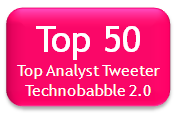This entry was cross-posted from Meanders: The Dow Brook Blog.
Software analysts and buyers have historically favored platforms over application suites and stand-alone applications. Why? Because platforms offer both a rich set of pre-integrated functionality and the ability to add or build new features and applications, some of which may be extensively customized for an organization.
IBM has long been considered a platform provider of enterprise software, particularly in the infrastructure and middleware categories. More recently, IBM has evolved from being a vendor of a collaboration suite (Quickr) to a provider of multiple integrated, extensible offerings for enterprise collaboration, social networking, messaging, content sharing and management, and customer- and employee-facing web experience management. IBM’s vision for for this confederation of offerings, codenamed ‘Project Vulcan’, was first articulated at Lotusphere 2010. Last year’s Lotusphere presented initial, limited evidence that the vision was becoming reality.
Lotusphere 2012, held last week, showcased IBM’s latest efforts at unifying its interaction platform. IBM previewed the upcoming releases of its Connections, Notes/Domino, and Customer and Intranet Web Experience offerings. As one would expect from a platform software provider, each of these products works with the others out of the box. However, IBM, has gone beyond merely providing integration between the separate offerings by embedding functionality from each into the others. For example, IBM customers who have licensed both Connections and Notes will soon be able to send and receive email from within Connections, and, conversely, consumers will be able to view and interact with the Connections activity stream from within Notes.
The increasing power of the IBM interaction platform was further underscored by demonstrations of related, integrated and embedded functional services from its Quickr collaboration, Content Manager and FileNet enterprise content management, and Cognos analytics offerings. This extended scope of the Project Vulcan vision is what sets IBM apart from other platform software vendors, and it was good to see IBM articulating and demonstrating that differentiation at Lotusphere.
Death of a Tradeoff
We, as an industry, have assumed the existence of a tradeoff between rich functionality and simple, intuitive user experiences. Conventional wisdom says that as more features are added, the resulting complexity degrades the user experience, forcing software architects and designers to find an optimal balance between functionality and usability. The tradeoff has traditionally been managed in one of two ways: 1) by creating simple, single-purpose applications that are not overloaded with functionality, or 2) by partitioning functionality into multiple, related applications in a suite. Platforms have largely not attempted to manage this tradeoff at all for developers/designers, administrators, or consumers. Not only is the platform’s complexity on full display; it is generally promoted as a benefit.
IBM’s implementation of its Project Vulcan vision has, for perhaps the first time, obviated the long-held tradeoff between functionality and ease-of-use at the platform level. The versions of Connections, Notes/Domino, and the Web Experience offerings that where announced and demonstrated at Lotusphere 2012 (and will be released over the course of this year) are both feature-rich and highly usable. Each offering has had its user interface redesigned, yielding a cleaner look that is more consistent across the interaction platform. Additionally, the new user interface designs are simpler than their predecessors and, in effect, minimize the complexity created by IBM’s extended integration and embedding of functionality from related software offerings.
This harmonious co-existence of broad, advanced functionality and a consumer-friendly computing experience is what makes IBM’s interaction platform really different and powerful. The first public glimpse of this next-generation enterprise software came during the Lotusphere 2012 Opening General Session, when Connections Next was demonstrated by its Lead Project Manager, Suzanne Livingston. My reaction, a tweet that was later displayed before the beginning of the Closing General Session, sums up the impact of IBM’s work on its interaction platform over the last year:

Dow Brook’s Point-Of-View
While there is more work to be done, IBM should be proud of the next-generation interaction platform it is bringing to market. Lotusphere 2012 demonstrated that IBM is in good position to be a provider of choice for social business software. The work that they’ve done over the last year strongly differentiates their interaction platform and should positively affect its adoption by customers. IBM’s refusal to acknowledge the old, limiting tradeoff between platform complexity and user experience should accelerate the consolidation of the Enterprise Social Software market in the second half of 2012. It may also more firmly establish IBM as a leader in the Web Experience software category and spark renewed interest in its Notes/Domino messaging and Sametime unified communications offerings.
Disclosure: IBM is a client of Dow Brook’s Insight OnDemand subscription advisory service and paid the author’s registration and hotel expenses related to Lotusphere 2012 attendance.




